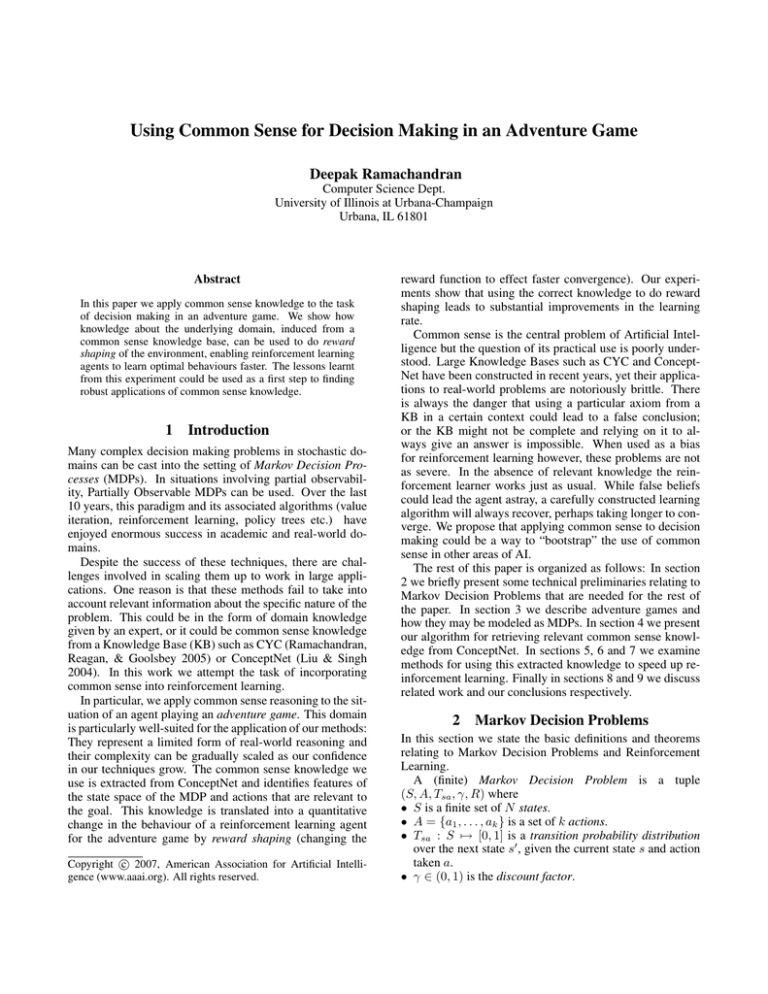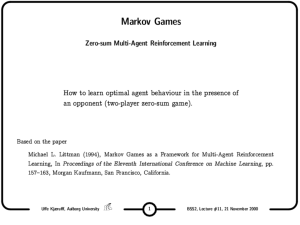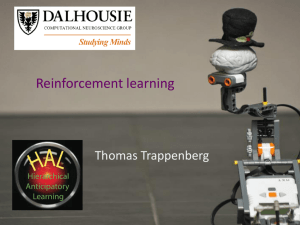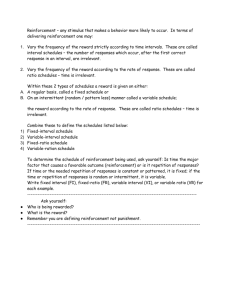
Using Common Sense for Decision Making in an Adventure Game
Deepak Ramachandran
Computer Science Dept.
University of Illinois at Urbana-Champaign
Urbana, IL 61801
Abstract
In this paper we apply common sense knowledge to the task
of decision making in an adventure game. We show how
knowledge about the underlying domain, induced from a
common sense knowledge base, can be used to do reward
shaping of the environment, enabling reinforcement learning
agents to learn optimal behaviours faster. The lessons learnt
from this experiment could be used as a first step to finding
robust applications of common sense knowledge.
1
Introduction
Many complex decision making problems in stochastic domains can be cast into the setting of Markov Decision Processes (MDPs). In situations involving partial observability, Partially Observable MDPs can be used. Over the last
10 years, this paradigm and its associated algorithms (value
iteration, reinforcement learning, policy trees etc.) have
enjoyed enormous success in academic and real-world domains.
Despite the success of these techniques, there are challenges involved in scaling them up to work in large applications. One reason is that these methods fail to take into
account relevant information about the specific nature of the
problem. This could be in the form of domain knowledge
given by an expert, or it could be common sense knowledge
from a Knowledge Base (KB) such as CYC (Ramachandran,
Reagan, & Goolsbey 2005) or ConceptNet (Liu & Singh
2004). In this work we attempt the task of incorporating
common sense into reinforcement learning.
In particular, we apply common sense reasoning to the situation of an agent playing an adventure game. This domain
is particularly well-suited for the application of our methods:
They represent a limited form of real-world reasoning and
their complexity can be gradually scaled as our confidence
in our techniques grow. The common sense knowledge we
use is extracted from ConceptNet and identifies features of
the state space of the MDP and actions that are relevant to
the goal. This knowledge is translated into a quantitative
change in the behaviour of a reinforcement learning agent
for the adventure game by reward shaping (changing the
c 2007, American Association for Artificial IntelliCopyright gence (www.aaai.org). All rights reserved.
reward function to effect faster convergence). Our experiments show that using the correct knowledge to do reward
shaping leads to substantial improvements in the learning
rate.
Common sense is the central problem of Artificial Intelligence but the question of its practical use is poorly understood. Large Knowledge Bases such as CYC and ConceptNet have been constructed in recent years, yet their applications to real-world problems are notoriously brittle. There
is always the danger that using a particular axiom from a
KB in a certain context could lead to a false conclusion;
or the KB might not be complete and relying on it to always give an answer is impossible. When used as a bias
for reinforcement learning however, these problems are not
as severe. In the absence of relevant knowledge the reinforcement learner works just as usual. While false beliefs
could lead the agent astray, a carefully constructed learning
algorithm will always recover, perhaps taking longer to converge. We propose that applying common sense to decision
making could be a way to “bootstrap” the use of common
sense in other areas of AI.
The rest of this paper is organized as follows: In section
2 we briefly present some technical preliminaries relating to
Markov Decision Problems that are needed for the rest of
the paper. In section 3 we describe adventure games and
how they may be modeled as MDPs. In section 4 we present
our algorithm for retrieving relevant common sense knowledge from ConceptNet. In sections 5, 6 and 7 we examine
methods for using this extracted knowledge to speed up reinforcement learning. Finally in sections 8 and 9 we discuss
related work and our conclusions respectively.
2
Markov Decision Problems
In this section we state the basic definitions and theorems
relating to Markov Decision Problems and Reinforcement
Learning.
A (finite) Markov Decision Problem is a tuple
(S, A, Tsa , γ, R) where
• S is a finite set of N states.
• A = {a1 , . . . , ak } is a set of k actions.
• Tsa : S 7→ [0, 1] is a transition probability distribution
over the next state s0 , given the current state s and action
taken a.
• γ ∈ (0, 1) is the discount factor.
• R : S × A 7→ R is a reward function, with absolute value
bounded by Rmax .
A policy is a map π : S 7→ A and the (discounted) value
of a policy π at state s1 ∈ S,denoted V π (s1 ) is given by:
V π (s1 ) = R(s1 , π(s1 )) + Es2 ,... [γR(s2 , π(s2 )) + . . . |π]
where P r(si+1 |si , π) = Tsi π(si ) (si+1 ) and E[·] means expectation. The goal of standard Reinforcement Learning is
to find an optimal policy π ∗ such that V π (s) is maximized
for all s ∈ S by π = π ∗ . Indeed, it can be shown (see for
example (Sutton & Barto 1998)) that at least one such policy
always exists for ergodic MDPs.
To solve an MDP means to determine the optimal policy,
given complete information about its transition and reward
functions. There are algorithms (e.g. policy iteration and
value iteration) that solve MDPs in time pseudo-polynomial
in the number of states, but these can be exponential in the
number of features that define the state.
Reinforcement Learning (RL) is the more general problem of learning an optimal policy when neither the transition
model nor the reward function is known, but must be discovered by taking actions in the MDP and making observations.
Most reinforcement learning algorithms involve a trade-off
between exploration of the state-space and exploitation of
the states already explored.
For the solution of MDPs, it is useful to define the following auxiliary Q-function:
Qπ (s, a) = R(s, a) + γEs0 ∼Psa (·) [V π (s0 )]
Finally, we state the following fundamental result concerning MDPs (Sutton & Barto 1998) :
Theorem 1 (Bellman Equations). Let a Markov Decision
Problem M = (S, A, Tsa , γ, R) and a policy π : S 7→ A be
given. Then,
1. For all s ∈ S, a ∈ A, V π and Qπ satisfy
X
Tsπ(s) V π (s0 )
(1)
V π (s) = R(s, π(s)) + γ
s0
Qπ (s, a) = R(s, a) + γ
X
Tsa (s0 )V π (s0 )
s0
2. π is an optimal policy for M iff, for all s ∈ S,
π(s) ∈ argmax Qπ (s, a)
(2)
a∈A
3
Adventure Games
The kind of problems we will be considering are those arising from text-based adventure games. In this popular subgenre of computer games, the user plays a character who is
placed in a controlled environment and has certain objectives to achieve (collect treasure, defeat enemies etc.). The
emphasis is on solving puzzles that require the use of complex decision-making and everyday reasoning. Adventure
games are attractive testbeds for trying out various AI techniques because they represent a circumscribed environment
where general ideas can be experimentally verified without
facing the full complexity of the real world (Hlubocky &
Amir 2004).
Figure 1: The Banana Game
The example that we will use to motivate this work will
be the following (called the “banana game” for historical
reasons) (Figure 1): Our agent is trapped in a dungeon, and
he can only escape through a door in one of the cells. The
door is locked but fortunately there is a key that can be found
in one of the rooms of the dungeon. The agent must locate
this key, pick it up and carry it to the room with the door,
use it to open the door and exit to freedom. There is also
a banana in one of the other rooms that the agent could try
opening the door with (Though he wouldn’t get very far).
Let us model this problem as an Markov Decision Process: The state representation will be a combination of the
position of the agent and the items he possesses. We define
the state-space through binary features such as has-key
and door-open. It is crucial for our techniques that the
feature names are descriptive and accessible to the algorithm. The available actions at each state are: moving, picking up or dropping items in the current room and attempting
to open the door. These actions lead to probabilistic state
transitions because each action has a small probability of
failing even if its preconditions are satisfied.
In this setting various tools from the MDP literature can
be used to solve and do reinforcement learning on the MDP.
However on application to larger problems these methods
become intractable. In the rest of this paper, we will be considering methods for improving the performance of these algorithms by using common sense knowledge about the task
(in the above case, the knowledge that having the key is necessary to open the door). Observe that our game can be made
arbitrarily complicated not only by increasing the number of
rooms, but by adding extraneous objects to confuse and slow
down the learner.
The other problem for which we will show experimental
results in this paper is the “flashlight game”. Briefly, a certain room needs to be lighted up. Scattered around the environment are a flashlight and a set of batteries. They must
be picked up (in either order) and then combined together in
the obvious way to illuminate the room. Note the similarity
of this problem with partial order planning.
4
Common Sense
What constitutes common sense knowledge is hard to pin
down precisely, but nevertheless it is believed to be vital for
true human level AI. An intelligent agent in our previous
example would know that given that his goal is to open the
door and escape the dungeon, a key would probably be of
more use than a banana. Our aim then is to use common
sense knowledge to determine which features of the state
space are relevant to the task at hand.
There have been a number of initiatives to construct large
common sense knowledge bases. At present the largest and
most comprehensive of these is Cycorp Inc’s CYC (Ramachandran, Reagan, & Goolsbey 2005). The representation language for CYC is a higher-order predicate logic that
includes support for contexts, modal extensions and nonmonotonicity. An example of a common sense axiom in
CYC relevant to the door example above is:
(implies (and
(agent-Possesses ?Agent ?Key)
(isa ?Key Key)
(isa ?Door Door)
(opensWith ?Agent ?Door ?Key ?T1)
(immediatelyAfter ?T1 ?T2))
(holdsIn ?T2 (isOpen ?Door)))
Algorithm FindRelevantConcept (MDP M = (S, A, T, γ, R) )
1. GF := getGoalFeatures(M )
2. For each feature f of S not in GF
3. For (f 0 , t0 ) ∈ GF
4.
If (f 0 , t0 ) ∈ ConceptNet.
project-consequences(f ) and tt0 > 0.01
5.
RF := RF ∪ (f, tt0 )
6.
GF := GF ∪ (f, tt0 )
7. Return RF
Algorithm getGoalFeatures (MDP M = (S, A, T, γ, R))
1. GF := ∅
2. For (s, a) ∈ S, A s.t. R(s, a) > 0.5
3. For each feature f of S
4.
If s.f = 0 and Es0 ∼Tsa [s0 .f ] > 0.5
5.
GF := GF ∪ (f, Es0 ∼Tsa [s0 .f ])
6. return GF
Figure 2: Extracting Relevant Features
The ideal way to exploit this knowledge for the problem
in section 3 is to perform abduction on the above axiom and
the goal condition:
(holdsIn END (isOpen Dungeon-Door)))
One of the conclusions of this abduction would be the
statement:
(agent-Possesses Agent Dungeon-Door-Key)
This can now be exploited by the agent when it solves the
MDP or performs reinforcement learning as discussed in the
following sections.
However the above idea, although intuitively the correct
thing to do, is difficult to implement. Translating between
the state representation used in our MDP to the logical axioms required by CYC to do inference is a difficult problem.
In contrast the semantic network representation of ConceptNet (Liu & Singh 2004) is much easier to work with. Knowledge in ConceptNet is less structured than in CYC, and is
closer to natural language. An example of ConceptNet’s representation (for the concept ’key’) is shown in figure 3.
Our algorithm for determining relevant features of the
state space from ConceptNet is shown in figure 2. Given
the underlying MDP, we first find the features of the goal
states that define the goal condition. Our method (algorithm getGoalFeatures) chooses features that are
likely to be “flipped” by the goal-achieving action e.g. the
open-door feature. More precisely, we choose features
that have a high probability of being turned on by a transition with high reward. The algorithm then calls ConceptNet’s project-consequences method on each feature
f in the state-space. This returns a set of concepts from ConceptNet that are the possible consequences of f (e.g. the
door is opened by the presence of the key). If one of these
consequences include a goal feature f 0 then we output f as
being relevant with a score equal to the score of f 0 (from
getGoalFeatures) times the relevance score between f
and f 0 returned by ConceptNet. We also add f to the list of
Figure 3: A projection of the ConceptNet term “open door”
finds the concept “key” for the binary relation “CapableOf”.
goal features with this score. Thus the search for relevant
features is done recursively.
An alternative to using algorithm getGoalFeatures
is to have annotated action names as well (such as
pick-key) and simply use these as the goal terms.
For the banana game example, the action of opening the
door in a state where the agent possesses the key gives
high positive reward, and these actions transition from states
where open-door is 0 to states where it is 1. Therefore, open-door is a goal feature with score 1. When
project-consequences is performed on the feature
have-key we get open-door as one of the consequences (Fig. 3) with relevance score 0.38. Thus we return
have-key as a relevant feature with score 0.38.
5
Value Initialization
We will first attempt to use common sense to solve the
simpler (but still theoretically intractable in the worst case)
problem of solving the adventure game MDP i.e. determining the optimal value function and policy given the transition
model and reward functions. We assume that we have complete knowledge of the environment including the transition
model. For the dungeon example, we know where the key,
the banana and the door is located. We also know the effects
our actions will have on the state. We can compute the optimal value function V by an iterative algorithm such as value
or policy iteration. The running time of these procedures are
pseudo-polynomial in the number of states but exponential
in the number of state features. The value iteration algorithm
is shown in figure 4. The initial value (V0 ) is typically set to
0 for all states in the standard version of the algorithm.
We attempted to use common sense knowledge to speed
up the convergence of value iteration by biasing the initial
V values of each state depending on the knowledge we have
about how desirable each state is. The idea is that the initial V0 value assigned to each state should be a function of
the set of relevant features (Section 4) that are currently active. In particular we set it to be equal to the sum of the
scores of each relevant and active feature returned by algorithm GetRelevantFeatures. That is,
X
V0 (s) =
f (s) · score(f )
f ∈F
where F is the feature set. It is also possible to multiply
this expression by a scaling factor proportional to the maximax
mum possible value, Vmax = R1−γ
.
Unfortunately, our experiments showed little improvement in the convergence times using this improved form of
value iteration. In figure 5(a) we show the number of iterations needed for convergence of value iteration in the banana
game, for both the biased initial values case and the uniformly zero initial values case for various state-space sizes
(number of rooms)1 . A similar plot is shown for the flashlight game in 5(b). The common sense knowledge seems to
make little difference in either case.
Studying the value iteration process on this game revealed
an interesting phenomenon that explains why the common
sense knowledge did not help in solving the MDP. Essentially, during the initialization, we bumped up the values for
“useful” states prematurely i.e. before there was a “reason”
for giving them a high value or more precisely, before the
bellman backup (i.e. iterative update) from the goal had
reached this state. Hence, within a few iterations, the value
of these bumped up states become indistinguishable from
those obtained by the uniformly initialized algorithm.
Our conclusion is that for common sense knowledge of
the value of a state to be useful for an MDP algorithm, it
must be persistent over iterations. This is an issue that we
will address in the next section.
6
Reward Shaping
Reward shaping, first described in (Cohen & Hirsh 1994), is
the process of restructuring the reward function of an MDP
so that an agent using reinforcement learning will converge
to an optimal policy faster. For example, in the banana game
1
Note that we have plotted the logarithm of the number of
rooms on the x-axis.
Algorithm Value-Iteration (MDP M = (S, A, T, γ, R),
Initial Value Function V0 )
1. V = V0 .
2. For t = 1, 2 . . . until convergence of Vt
3.
For each s ∈ S
4.
Vt (s) := maxa∈AP
[R(s, a)
+ γ s0 ∈S T (s, a, s0 )Vt−1 (s0 )]
5. Return Vt
Figure 4: Value Iteration
(a) Banana Game
(b) Flashlight Game
Figure 5: Value iteration experiments
we could reshape the reward function so that the agent gains
a small positive reward for states where he possessed the key.
He would then learn to perform this action without needing
a full backup of the bellman update to the goal state.
Reward Shaping is especially useful in environments with
delayed rewards, where the agents must execute a complex
sequence of actions, moving through a number of states before obtaining a reward. MDPs with such sparse reward
structures are notoriously difficult for reinforcement learning, sometimes requiring exponentially many steps before
convergence.
The danger with this method is that indiscriminate reward
shaping can change the optimal policy in unforeseen ways.
For example, if the agent gets a very high reward for picking
up the key, it might then become optimal to simply keep
picking up and dropping the key repeatedly. Reward shaping
needs to be done in such a way that faster convergence is
obtained but the optimal policy remains invariant.
(Ng, Harada, & Russell 1999) first characterized the set
of reward functions that satisfies this policy-invariance property in a slightly different setting. We give a similar result
for our MDP framework.
Definition 1. Let any S, A, γ < 1 and a function F : S ×
A 7→ R be given. We say F is a potential-based shaping
function if there exists a real-valued function Φ : S 7→ R
(called the potential function) such that for all s ∈ S, a ∈ A,
F (s, a) = γEs0 ∼Psa [Φ(s0 )] − Φ(s)
The idea is that F is a shaping function that is added to the
normal reward function R for an MDP. The potential-based
property ensures that the optimal policy does not change between R and R + F . In fact, any such policy-invariant shaping function has to be of this form as the following theorem
shows:
Theorem 2. Let M = (S, A, T, γ, R) be an MDP. Let F :
S × A 7→ R be some shaping function. Then,
1. If F is potential-based, then every optimal policy for
M 0 = (S, A, T, γ, R + F ) will also be an optimal policy for M (and vice versa).
2. If F is not potential-based, then there exists a transition
function T and a reward function R such that no optimal
policy for M 0 is optimal for M .
Proof. See appendix.
(b) Flashlight Game
Figure 6: Reward shaping experiments
The intuition behind choosing a potential-based shaping
function is that the agent cannot get a net positive reward by
travelling in a cycle of states s1 → s2 → . . . → s1 .
We have thus chosen to perform reward shaping with a
potential-based shaping function to ensure that the optimal
policy remains invariant. The potential function Φ that we
use will be the same as the initial value function defined in
section 5, i.e. the sum of the relevancy scores for each active
feature of the state space:
X
Φ(s) =
f (s) · score(f )
f ∈F
In contrast to value initialization, the reinforcement gained
by the agent through reward shaping with common sense
knowledge is persistent across iterations because the underlying MDP is now fundamentally different. This has a much
more significant effect on the convergence rates. As shown
in figure 6, there is roughly a 60% improvement in the convergence times. The reinforcement learner in these experiments implemented a Q-learning algorithm (see (Sutton &
Barto 1998)) with a Boltzmann exploration strategy.
7
(a) Banana Game
Further Ideas
Here we discuss some more methods of incorporating common sense knowledge into probabilistic decision making:
1. Value Function Approximation : In domains where the
state space is so large that the value function cannot be efficiently represented in tabular form, a linear basis function is used to compactly represent an approximate value
function. An LBF is a weighted sum of basis functions of
state variables. Solution techniques exists for determining
the weights by gradient descent, but the choice of the basis functions themselves must be made by the domain expert. Common sense knowledge can be used to deduce a
relevant sets of basis functions for the value function from
the specific nature of the problem e.g. a basis function that
measured the distance from each item in the dungeon.
2. Exploration Strategy : Reward shaping is a strategy for
a teacher. The reinforcement learning agent has no control
itself over the reinforcement given by the environment.
However one aspect of the system that it does control is
the exploration strategy. Typically, agents try to find a
balance between greedy exploitation strategies and exploration strategies that perform sub-optimal actions in the
hope of eventually discovering higher value regions of the
state-space. Common sense could guide the exploration
strategy used by the agent e.g. such a strategy would prescribe attempting the action pick-key more often than
pick-banana.
3. Factoring MDPs : Recently there has been a lot of interest in factored MDPs (Guestrin, Koller, & Parr 2001).
These are formalisms that decompose the state representations into sets of independent features and do reinforcement learning on these sub-spaces semi-independently.
Common sense information could be used to determine
how to decompose large state-spaces e.g. pairs of features
that have low relevance scores (like have-banana and
open-door could be factored into separate MDPs.)
8
Related Work
To our knowledge, there has been no work so far on using
common sense knowledge for improved decision making in
stochastic domains, but there has been work on reward shaping by explanation-based learning (Laud & DeJong 2002).
The idea of using domain knowledge for traditional planning problems has been explored in relatively more depth.
For example TALPlanner (Kvarnström & Doherty 2001) is
a forward-chaining planner that utilizes domain-dependent
knowledge to control search in the state space.
Other related ideas we plan to explore to obtain deeper
insights into the problem, is the work on Relational MDPs
(Mausam & Weld 2003) and First-Order MDPs (Boutilier,
Reiter, & Price 2001). While both these formalisms seem
to be better suited to the task of exploiting knowledge (especially in logical form) we did not use them for this work,
because as of now neither of them have been developed to
the point where useful implementations exist and there has
not been sufficient work on reinforcement learning or reward
shaping for them.
9
Conclusions
Our results demonstrate that when used judiciously, it is possible to exploit common sense knowledge to improve reinforcement learning algorithms. The challenge is to do it in
sufficient generality that it can be usefully re-applied to a
number of different problems. One issue that we have finessed for now is the reference problem : how to connect
the features in the state-based representation in the MDP to
the language of the common sense KB. Here we have assumed that both representations use the same vocabulary.
The advantage that using common sense for decision
making has over most other uses of common sense is its robustness to error and incompleteness. We might not find any
useful common sense at all in which case our reinforcement
learning algorithm will work as usual. Making the wrong
conclusions from the KB might cause the learning agent to
go astray. But if the knowledge is used carefully (e.g. with
potential-based reward shaping), it will always be able to recover and still find the optimal policy. Thus the common
sense would hopefully be beneficial most of the time or it
might slow down the reinforcement learner sometimes, but
it will not cause a catastrophic failure. It might turn out
that supporting decision making might be the first truly useful application for common sense knowledge bases that are
large but incomplete i.e. not comprehensive enough to cover
all of common sense knowledge.
A
Proof of Theorem 2
The optimal Q function for M , Q∗M satisfies the Bellman
equations (1),
Q∗M (s, a) = R(s, a) + γEs0 ∼Psa [max
Q∗M (s0 , a0 )]
0
a ∈A
Subtracting Φ(s) and rearranging terms on the right hand
side:
Q∗M (s, a) − Φ(s)
= R(s, a) + γEs0 ∼Psa [Φ(s0 )] − Φ(s)
+γEs0 ∼Psa [max
Q∗M (s0 , a0 ) − Φ(s0 )]
0
a ∈A
Let Q̂M 0 (s, a) , Q∗M (s, a) − Φ(s).
Q̂M 0 (s, a) = R0 (s, a) + γEs0 ∼Psa [max
Q̂M 0 (s0 , a0 )]
0
a ∈A
So Q̂M 0 satisfies the Bellman equation for M 0 and must be
the optimal Q function. Therefore the optimal policy for M 0
satisfies:
∗
πM
0 (s)
∈
argmax Q∗M 0 (s, a)
=
argmax Q∗M (s, a) − Φ(s)
=
argmax Q∗M (s, a)
a∈A
a∈A
a∈A
and so π ∗ is also optimal for M . For the other direction, we
can simply interchange the roles of M and M 0 .
For the proof of part 2 see (Ng, Harada, & Russell 1999).
References
Boutilier, C.; Reiter, R.; and Price, B. 2001. Symbolic
dynamic programming for first-order MDPs. In Proc. Seventeenth International Joint Conference on Artificial Intelligence (IJCAI ’01), 690–700.
Cohen, W. W., and Hirsh, H., eds. 1994. Reward functions
for accelerated learning. CA: Morgan Kauffman.
Guestrin, C.; Koller, D.; and Parr, R. 2001. Multiagent
planning with factored mdps. In In 14th Neural Information Processing Systems (NIPS-14).
Hlubocky, B., and Amir, E. 2004. Knowledge-gathering
agents in adventure games. In AAAI-04 workshop on Challenges in Game AI.
Kvarnström, J., and Doherty, P. 2001. Talplanner: A
temporal logic based forward chaining planner. Annals
of Mathematics and Artificial Intelligence (AMAI) Volume
30:pages 119–169.
Laud, A., and DeJong, G. 2002. Reinforcement learning and shaping: Encouraging intended behaviors. In Proceedings of the 19th International Conference on Machine
Learning (ICML-02), 355–362.
Liu, H., and Singh, P. 2004. Conceptnet: A practical commonsense reasoning toolkit. BT Technology Journal 22.
Mausam, and Weld, D. S. 2003. Solving relational MDPs
with first-order machine learning. In Proc. ICAPS Workshop on Planning under Uncertainty and Incomplete Information.
Ng, A. Y.; Harada, D.; and Russell, S. 1999. Policy invariance under reward transformations: theory and application to reward shaping. In Proc. 16th International Conf.
on Machine Learning, 278–287. Morgan Kaufmann, San
Francisco, CA.
Ramachandran, D.; Reagan, P.; and Goolsbey, K. 2005.
First-orderized researchcyc: Expressivity and efficiency in
a common-sense ontology. In Papers from the AAAI Workshop on Contexts and Ontologies: Theory, Practice and
Applications.
Sutton, R. S., and Barto, A. G. 1998. Reinforcement Learning. MIT Press.








